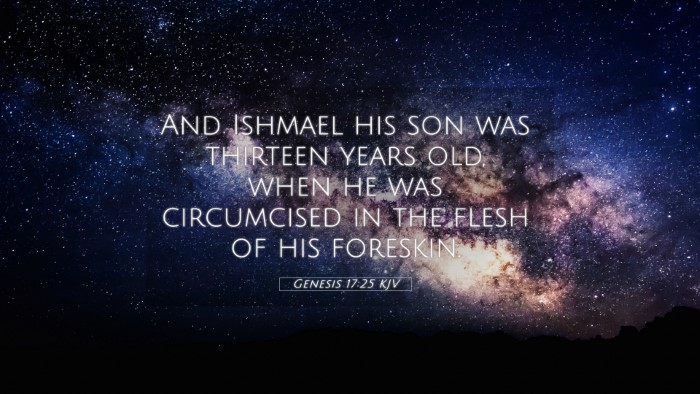Understanding Genesis 17:25
Genesis 17:25 states: "And Ishmael his son was thirteen years old, when he was circumcised in the flesh of his foreskin."
This verse is instrumental in understanding God's covenant with Abraham and the significance of circumcision in the biblical narrative. It marks a pivotal moment in the life of Ishmael, Abraham's firstborn son, and introduces the theme of covenantal identity and obedience to God's commands.
Commentary Insights
The public domain commentaries provide rich insights into the meaning of this verse, highlighting its theological, historical, and moral implications.
Matthew Henry's Commentary
Matthew Henry emphasizes the obedience of Abraham, noting that Ishmael’s circumcision represents a crucial step in fulfilling God’s command. This act of obedience not only signifies covenant membership but also illustrates the importance of familial duties in honoring God’s mandates.
Albert Barnes' Commentary
Albert Barnes draws attention to the age of Ishmael at the time of his circumcision, suggesting that this highlights God's patience and mercy. Barnes interprets Ishmael’s circumcision as a sign of God’s promise to bless him, though it also foreshadows the distinct paths that the descendants of Isaac and Ishmael would take.
Adam Clarke's Commentary
Adam Clarke focuses on the cultural practice of circumcision as a sign of covenant in the ancient Near Eastern context. He asserts that this act not only binds Ishmael to Abraham's covenant with God but also serves as a foundation for understanding the subsequent development of the Hebrew identity and their relationship with God.
Thematic Connections
This verse resonates throughout Scripture, establishing links with various themes and other biblical texts.
- Genesis 17:10-11: The command of circumcision as a sign of the covenant.
- Genesis 21:4: Abraham’s obedience in the circumcision of Isaac, highlighting continuity in God's covenant.
- Exodus 4:24-26: The serious nature of circumcision in God's plan and its implications for Moses.
- Matthew 3:9: Reference to "children of Abraham," alluding to covenantal identity beyond ethnic lines.
- Romans 4:11: Paul’s discussion of faith and circumcision as a sign for all who believe.
- Galatians 5:2-6: Paul addressing the relevance of circumcision in the context of faith and grace.
- Colossians 2:11: Spiritual circumcision in Christ, connecting physical and spiritual identity.
Cross-Referencing Insights
When studying Genesis 17:25, it is essential to explore how it relates to other verses, thereby enhancing our understanding of biblical themes. The connections allow for a deeper comprehension of God’s ongoing covenant with humanity.
- Tools for Bible Cross-Referencing: Utilizing concordances and reference guides can enhance one's study by identifying thematic parallels.
- Comparative Bible Verse Analysis: Investigating the relationships between texts gives context to God’s narrative throughout the scriptures.
- Inter-Biblical Dialogue: Encourages the believer to engage with various scriptures to experience the wholeness of the divine narrative.
- Cross-Referencing Bible Study Methods: Techniques such as thematic studies and chain references can be employed for deeper exploration.
Conclusion
Genesis 17:25 is not merely a historical remark; it is a crucial element in the unfolding story of God’s covenant with His people. Understanding this verse through public domain commentaries reveals its layered meanings, as well as its connections to other scripture. Embracing the interconnectedness of biblical texts enhances our comprehension and invites a richer engagement with the Word of God.


